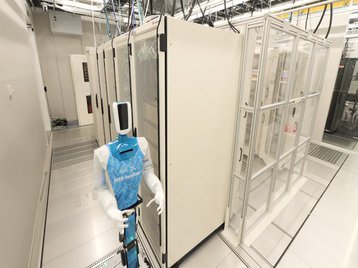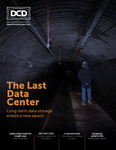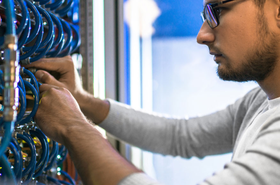Robots have long inspired fear and enthusiasm in equal measures. But in the modern data center, the deployment of robots at a large scale has been subject to some false starts, with several high-profile projects failing to progress past the prototype or pilot stage. Despite the hype, manual operations have remained the norm for most data centers.
However, the tide is starting to turn. The pressures and demands on data center infrastructure brought about by the pandemic - coupled with significant advancements in AI – is enabling a new generation of flexible robots that can navigate every corner of the building. Operational benefits, including efficiency and safety improvements, are now more widely recognized throughout the industry: Gartner even predicts that half of cloud data centers will be deploying advanced robots with AI capabilities by 2025.
But to appreciate the new role of robotics in driving operational excellence, it’s important to look beyond old conceptions of the ‘lights-out’ data center, where automated facilities eliminate the need for human intervention altogether. Instead, the true strengths of robotics can be found in how the technology complements and augments the expertize of data center personnel. When human skill meets the precision and speed of robots, processes can be more seamlessly integrated with 360-degree intelligence.
The heat is on
Global data center demand continues to surge, even as the shock of the Covid-19 pandemic dissipates. To meet this demand and accommodate a plethora of new technologies and applications, today’s data center has become more complex, vast, and interconnected than ever before. In London alone, a 24 percent rise in data center capacity was recorded over the course of 2021.
This means that teams are under 24x7 pressure to ensure the smooth, efficient running of data center operations. But the proactive monitoring of all these components – spanning IT, facilities, and security – is becoming increasingly challenging. Staff require unprecedented levels of visibility and operational efficiency to respond to concurrent issues and faults in real time – no mean feat in today’s hyperscale, maze-like structures.
The increasing scale of data centers also brings pressures and concerns around security, compliance, and efficiency. The ecosystem is, quite literally, getting hotter: increased energy demand is adding urgency to the need for new and innovative ways to optimize efficiency and cooling effectiveness.
To keep up with these mounting operational demands, a multidisciplinary, all-in-one solution is required. Therefore, the latest innovations in robotics can streamline and transform manual data center processes in order to drive greater efficiencies, faster response and resolution times, and lower risks of human error.
Intelligent decision-making
Robots can help provide a ‘single source of truth’ – or end-to-end visibility – for dispersed teams across the data center, ensuring easy access to siloed data and enhancing collaboration. This is particularly crucial in an environment where security, IT, and facilities must communicate quickly and harmoniously to support the smooth running of all operations. Without this centralized visibility, proactive and timely problem-solving is extremely difficult, meaning that faults or safety hazards may go unnoticed and unaddressed until they escalate into bigger issues.
Automated technology provides a comprehensive overview of the entire ecosystem, supporting and streamlining the work of human personnel to achieve maximum efficiency. A single machine can obtain 4K, in-depth and 360-degree visibility across all already of the data center, diligently resolving issues and communicating any irregularities back to the relevant teams for analysis. This, in turn, allows for timely and intelligent decision-making whilst ensuring minimal disruption to daily operations.
Therefore, robots allow operators to blend human expertise with automated precision and speed, which not only bolsters security and compliance – critical concerns for all involved in data center operations – but also enhances functionality across the ecosystem. For example, a robot can carry out exhaustive hazard checks in a very short period of time, whilst simultaneously communicating data insights around security, facility, and environmental health to ensure multi-departmental cohesion.
Navigating the data center
As data centers become more sprawling and densely populated, robots can provide decision-makers with a level of visibility, speed, and multi-layered intelligence that no single human or static camera can replicate. Robotics use innovative self-driving technology to autonomously map and navigate the data center, establishing norms and swiftly escalating anomalies for human analysis. AI-driven sensors and live visualizations of energy dynamic, such as heat mapping, can then accurately detect anything from temperature and Wi-Fi signal strength to air quality index, smoke, and gas levels inside the building.
The real-time reports provided allow any issues to be proactively addressed, helping data centers to mitigate their footprint, manage infrastructure complexity, and maintain customer satisfaction. And with advanced reporting of areas like humidity and temperature levels, operators can benefit from increased visibility as better balance of workloads, costs, and energy efficiency throughout the data center.
This capability is increasingly important at a time when 24 percent of unplanned data center outages are caused by environmental factors like weather, water, heat, or CRAC failure. In the labyrinthine modern data center, robots may well have found their place traversing these highly interdependent and large-scale structures.
Rise of the robots
Fears of robots “taking over” still persist, although attitudes may have recently shifted somewhat. But in today’s data center, evolution – not revolution – is the name of the game. Robots are increasingly finding their place in the data center, and it’s beside humans, rather than instead of them.
In fact, the only jobs robots are likely to take from data center personnel in the future are the ones that employees should not have to do in the first place. By excelling at the most mundane, repetitive, and time-consuming elements of data center work, robots support and complement the skills of human teams, freeing them to focus on more strategic areas of the business. This ultimately improves the workflow of tasks within the data center, yielding greater insights and innovation to meet the challenges of escalating demand.
As data center robotics increasingly come of age, could we be seeing a new chapter in efficiency and operational excellence?






